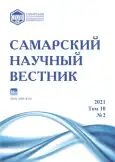The analysis of environmental space conditions for bryoflora forming in artificial pine communities of the Buzuluksky pine forest and the Krasnosamarsky forest
- Authors: Bogdanova Y.A.1, Prokhorova N.V.1, Kavelenova L.M.1
-
Affiliations:
- Samara National Research University
- Issue: Vol 10, No 2 (2021)
- Pages: 18-23
- Section: General Biology
- URL: https://journals.rcsi.science/2309-4370/article/view/78090
- DOI: https://doi.org/10.17816/snv2021102102
- ID: 78090
Cite item
Full Text
Abstract
The paper deals with ecological conditions and peculiarities of bryoflora of artificial pine communities of the Buzuluksky pine forest and the Krasnosamarsky forest. The authors have revealed that the pine plantings of the Buzuluksky pine forest are characterized by a lower soil moisture and nitrogen supply than similar communities of the Krasnosamarsky forest in accordance with the criteria of D.N. Tsyganov scales. In addition, all communities belonging to the same territory show differences in the acidity and salt regime of soils as well as in moisture contrasts. The differences seem to be the result of a specific manifestation of parallel multidirectional successional processes (afforestation and steppe formation). For the bryofloras of the studied artificial pine communities, a significant similarity level (Czekanowski-Sörensen index of 0,7) and close values of the projective cover and vitality of bryophytes have been shown. However, the substrate preferences of bryophytes are significantly different: 85% of the species grow on soil in the Buzuluksky pine forest, while 52% of the species grow on soil and 39% of the species grow on decaying wood in the Krasnosamarsky forest. In addition, more intensive sporulation of bryophytes has been noted in artificial pine communities of the Krasnosamarsky forest and the share of dominant species in the projective cover is 47,7% there, and their share is 83,4% in the Buzuluksky pine forest. The authors have suggested that genetic polymorphism should underlie the revealed differences in the species similarity of bryofloras. Its manifestation is influenced, among other things, by the stage of ecological succession of plant communities in which bryophytes grow. It is the result of the implementation of strategies for bryophytes adaptation to existing conditions and reflects the stage of bryoflora formation.
Full Text
##article.viewOnOriginalSite##About the authors
Yana Andreevna Bogdanova
Samara National Research University
Email: bogdanova.ya@yandex.ru
technician of Ecology, Botany and Nature Protection Department; Samara National Research University (Samara, Russian Federation)
Russian Federation, SamaraNataliya Vladimirovna Prokhorova
Samara National Research University
Email: natali.prokhorova.55@mail.ru
doctor of biological sciences, professor of Ecology, Botany and Nature Protection Department
Russian Federation, SamaraLyudmila Mikhailovna Kavelenova
Samara National Research University
Author for correspondence.
Email: lkavelenova@mail.ru
doctor of biological sciences, professor, head of Ecology Botany and Nature Protection Department
Russian Federation, SamaraReferences
- Чадаева В.А., Шхагапсоев С.Х. Теоретические аспекты стратегий жизни дикорастущих видов растений // Юг России: экология, развитие. 2016. Т. 11, № 4. С. 93–109.
- Матвеев Н.М. Основы степного лесоведения профессора А.Л. Бельгарда и их современная интерпретация // Самарская Лука: проблемы региональной и глобальной экологии. 2014. Т. 23, № 1. С. 5–92.
- Бельгард А.Л. Лесная растительность юго-востока УССР. Киев: Изд-во Киевского гос. ун-та, 1950. 294 с.
- Раменский Л.Г., Цаценкин И.А., Чижиков О.Н., Антипин Н.А. Экологическая оценка кормовых угодий по растительному покрову. М.: Сельхозгиз, 1956. 472 с.
- Цыганов Д.Н. Фитоиндикация экологических режимов в подзоне хвойно-широколиственных лесов. М.: Наука. 1983. 196 с.
- Матвеев Н.М. Биоэкологический анализ флоры и растительности (на примере лесостепной и степной зоны): учеб. пособие. Самара: Самарский университет, 2006. 311 с.
- Золотова Е.С., Иванова Н.С. Использование шкал Д.Н. Цыганова для анализа экологического пространства типов леса среднего Урала // Фундаментальные исследования. 2015. № 2–23. С. 5114–5119.
- Матвеев Н.М. Основы степного лесоведения профессора А.Л. Бельгарда и их современная интерпретация: учеб. пособие. Самара: Самарский университет, 2011. 126 с.
- Бузулукский бор / А.А. Чибилев, П.В. Вельмовский, Н.О. Кин и др. Екатеринбург: Уральское отделение РАН, 2008. 186 с.
- Чернышенко С.В. Амфиценотичность и биоразнообразие лесных биогеоценозов степной зоны Украины // Екологія та ноосферологія. 2005. Т. 16, № 3–4. С. 121–134.
- Ковтун С.Ю., Петрищев В.П. Геоэкологические проблемы Бузулукского бора // Вестник Оренбургского государственного университета. 2007. Специальный выпуск (67). С. 207–214.
- Климентьев А.И. Бузулукский бор: почвы, ландшафты и факторы географической среды. Екатеринбург: УрО РАН, 2010. 401 с.
- Камышова Л.В. Структура лесных насаждений заповедной зоны национального парка «Бузулукский бор» // Известия Оренбургского государственного аграрного университета. 2010. № 2 (26). С. 214–215.
- Методы изучения лесных сообществ / под ред. В.Т. Ярмишко, И.В. Лянгузовой. СПб.: НИИ Химии СПбГУ, 2002. 240 с.
- Баишева Э.З. Разнообразие мохообразных естественных экосистем: подходы к изучению и особенности охраны // Успехи современной биологии. 2007. Т. 127, № 3. С. 316–333.
- Богданова Я.А. Выявление биоморф мохообразных искусственных сосновых сообществ Красносамарского лесного массива (Самарская область) // Биодиагностика состояния природных и природно-техногенных систем: мат-лы ХIV всерос. науч.-практ. конф. c междунар. уч. Кн. 2. Киров: ООО «Издательство «Радуга-Пресс», 2016. С. 102–105.
- Богданова Я.А., Корчиков Е.С. Биоэкологическая характеристика мохообразных лесных сообществ Красносамарского лесного массива // Известия Самарского научного центра Российской академии наук. 2017. Т. 19, № 2 (2). С. 224–228.
- Богданова Я.А., Корчиков Е.С. Предварительные результаты изучения бриоценофлор сосновых сообществ Красносамарского лесного массива и национального парка «Бузулукский бор» // Экологический сборник 6: тр. молодых ученых Поволжья: междунар. молодежная науч. конф. / под ред. канд. биол. наук С.А. Сенатора, О.В. Мухортовой и проф. С.В. Саксонова. Тольятти: ИЭВБ РАН, «Кассандра», 2017. С. 50–52.
- Зайцев Г.Н. Математическая статистика в экспериментальной ботанике. М.: Наука, 1984. 424 с.
- Longton R.E. Reproductive ecology of bryophytes: what does it tell us about the significance of sexual reproduction // Lindbergia. 2006. Vol. 31. P. 16–23. doi: 10.2307/20150203.
- Newton A.E., Mishler B.D. The evolutionary significance of asexual reproduction in mosses // The Journal of the Hattori Botanical Laboratory. 1994. № 76. P. 127–145. doi: 10.18968/jhbl.76.0_127.
Supplementary files









